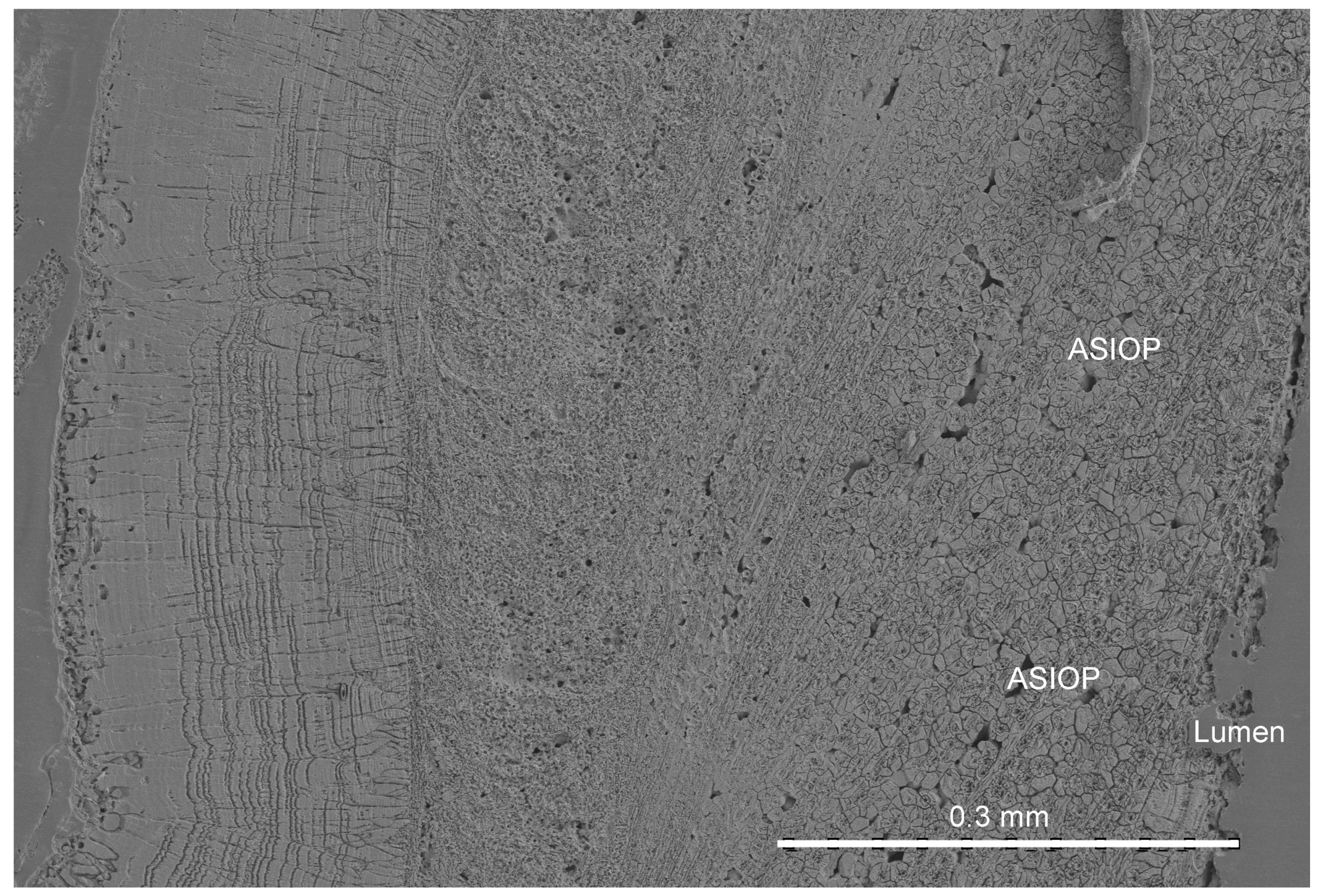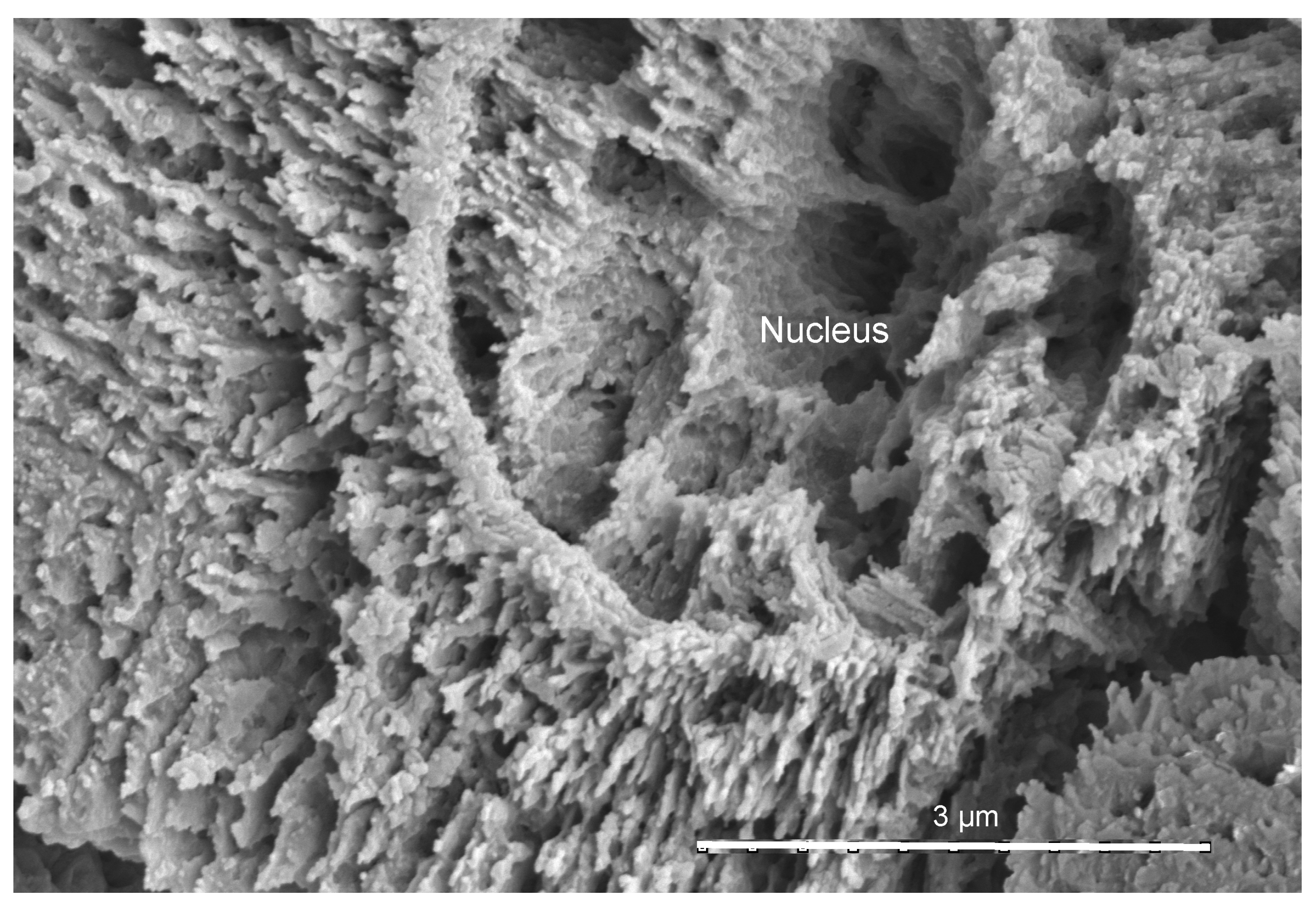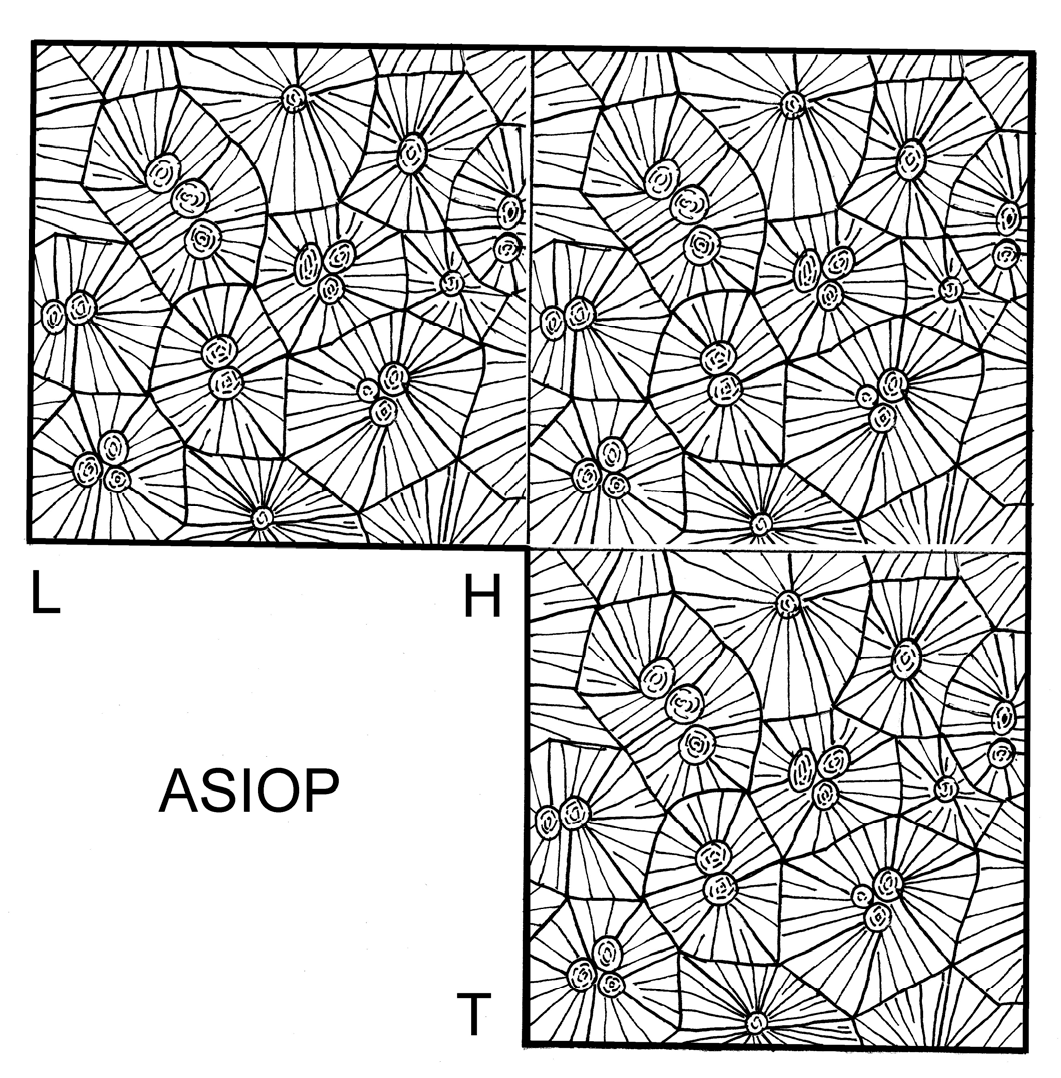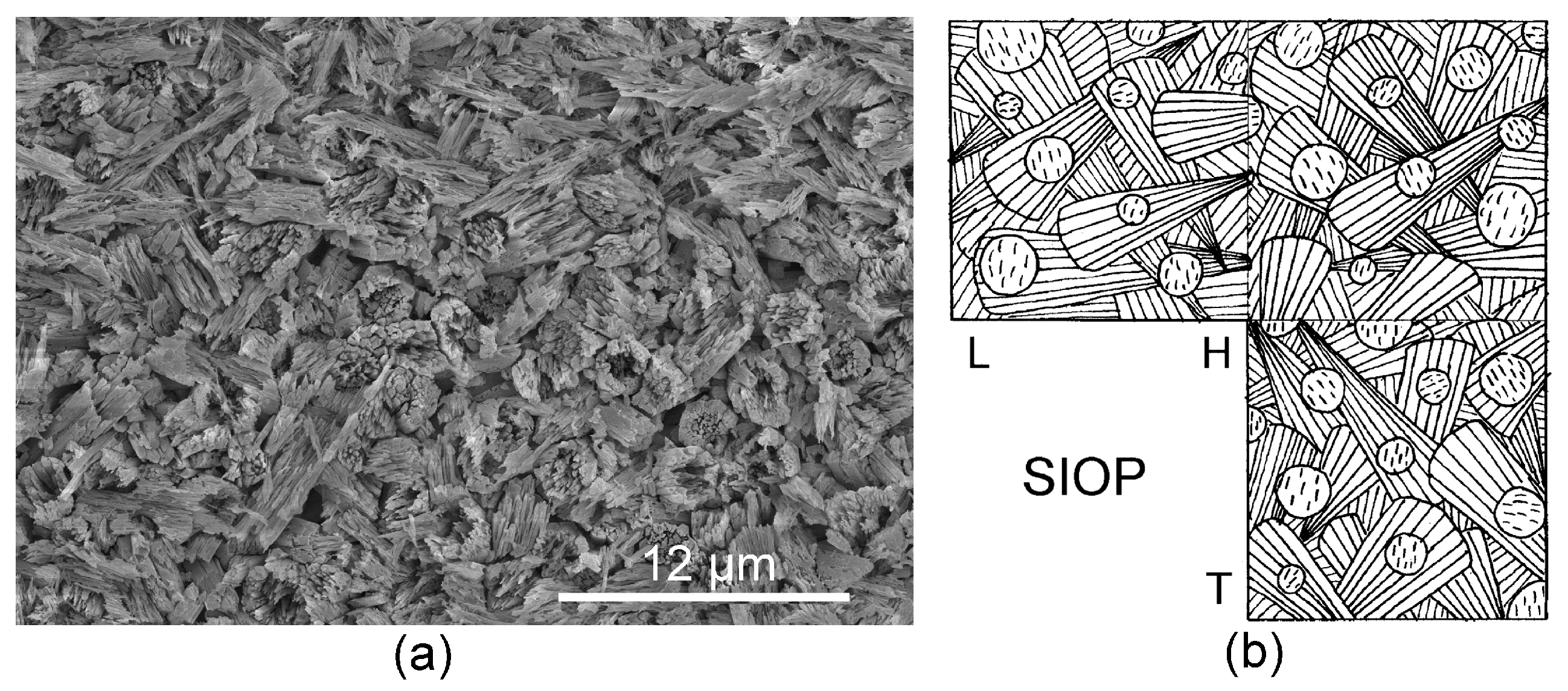New Type of SIOP Structure in Serpulidae: Formation and Evolutionary Implications
Abstract
1. Introduction
2. Materials and Methods
3. Results
4. Discussion
4.1. Formation of the Structure
4.1.1. Discussion of the Process
4.1.2. Serpulid Calcification Models and ASIOP Structure
4.2. Evolution of Serpulid Microstructures and ASIOP Structure
4.3. Similar Structures in the Other Invertebrates
5. Conclusions
Author Contributions
Funding
Data Availability Statement
Acknowledgments
Conflicts of Interest
References
- Vinn, O.; Ten Hove, H.A.; Mutvei, H.; Kirsimäe, K. Ultrastructure and mineral composition of serpulid tubes (Polychaeta, Annelida). Zool. J. Linn. Soc. 2008, 154, 633–650. [Google Scholar] [CrossRef]
- Vinn, O.; Ten Hove, H.A.; Mutvei, H. On the tube ultrastructure and origin of calcification in sabellids (Annelida, Polychaeta). Palaeontology 2008, 51, 295–301. [Google Scholar] [CrossRef]
- Vinn, O. The ultrastructure of calcareous cirratulid (Polychaeta, Annelida) tubes. Est. J. Earth Sci. 2009, 58, 153–156. [Google Scholar] [CrossRef]
- Sanfilippo, R.; Rosso, A.; Reitano, A.; Insacco, G. First record of sabellid and serpulid polychaetes from the Permian of Sicily. Acta Palaeontol. Pol. 2017, 62, 25–38. [Google Scholar] [CrossRef]
- Fischer, R.; Pernet, B.; Reitner, J. Organomineralization of cirratulid annelid tubes-fossil and recent examples. Facies 2000, 42, 35–50. [Google Scholar] [CrossRef]
- Bandel, K. The reconstruction of “Hyolithes kingi” as annelid worm from the Cambrian of Jordan. Mitt. Geol.-Paläontol. Inst. Univ. Hamburg 1986, 61, 35–101. [Google Scholar]
- Zibrowius, H.; ten Hove, H.A. Neovermilia falcigera (Roule, 1898), a deep- and cold-water serpulid polychaete common in the Mediterranean Plio-Pleistocene. Bull. Biol. Soc. 1987, 7, 259–271. [Google Scholar]
- Hove, H.A.T.; Smith, R.S. A re-description of Ditrupa gracillima Grube, 1878 (Polychaeta, Serpulidae) from the Indo-Pacific, with a discussion of the genus. Rec. Aust. Mus. 1990, 42, 101–118. [Google Scholar] [CrossRef]
- Sanfilippo, R.; Mòllica, E. Serpula cavernicola Fassari and Mòllica, 1991 (Annelida Polychaeta): Diagnostic features of the tubes and new Mediterranean records. Mar. Life 2000, 10, 27–32. [Google Scholar]
- Sanfilippo, R. Additional notes on the little known serpulid Serpula israelitica Amoreux, 1976 and new Mediterranean records. In Atti III Giornate di Paleontologia Maggio; Società Paleontologica Italiana: Modena, Italy, 2003. [Google Scholar]
- Nishi, E. On the internal structure of calcified tube walls in Serpulidae and Spirorbidae (Annelida, Polychaeta). Mar. Foul. 1993, 10, 17–20. [Google Scholar] [CrossRef]
- Sanfilippo, R. Spirorbid Polychaetes as boreal guests in the Mediterranean Pleistocene. Riv. Ital. Paleontol. Strat. 1998, 104, 279–286. [Google Scholar]
- Sanfilippo, R. Ditrupa brevis n.sp., a new serpulid from the Mediterranean Neogene with comments on the ecology of the genus. Riv. Ital. Paleontol. Strat. 1999, 105, 455–464. [Google Scholar]
- Weedon, M.J. Tube microstructure of Recent and Jurassic serpulid polychaetes and the question of the Palaeozoic ‘spirorbids’. Acta Palaeontol. Pol. 1994, 39, 1–15. [Google Scholar]
- Senowbari-Daryan, B. Barbafera carnica Senowbari-Daryan, 1980: A Triassic Worm-tube. Facies 1997, 36, 57–68. [Google Scholar] [CrossRef]
- Vinn, O.; Mutvei, H.; Ten Hove, H.A.; Kirsimäe, K. Unique Mg-calcite skeletal ultrastructure in the tube of the serpulid polychaete Ditrupa. Neues Jahrb. Geol. Paläontol. 2008, 248, 79–89. [Google Scholar] [CrossRef]
- Buckman, J.O. The tube of Ditrupa bartonensis (Annelida, Serpulidae), from the Eocene of southern England: Observations on microstructure and its significance. Palaeontol. Electr. 2020, 23, a37. [Google Scholar] [CrossRef]
- Hedley, R.H. Studies on serpulid tube formation. I. The secretion of the calcareous and organic components of the tube by Pomatoceros triqueter. Quart. J. Microsc. Sci. 1956, 97, 411–419. [Google Scholar] [CrossRef]
- Hedley, R.H. Studies on serpulid tube formation. II. The calcium-secreting glands in the peristomium of Spirorbis, Hydroides and Serpula. Quart. J. Microsc. Sci. 1956, 97, 421–427. [Google Scholar] [CrossRef]
- Hedley, R.H. Tube formation by Pomatoceros triqueter (Polychaeta). J. Mar. Biol. Assoc. U. K. 1958, 37, 315–322. [Google Scholar] [CrossRef]
- Neff, J.M. Ultrastructural studies of the secretion of calcium carbonate by the serpulid polychaete worm, Pomatoceras caerulus. Zeit. Zellforsch. 1971, 120, 160–186. [Google Scholar] [CrossRef] [PubMed]
- Neff, J.M. Ultrastructure of calcium phosphate containing cells in the serpulid Pomatoceros caeruleus. Calc. Tiss. Res. 1971, 7, 191–200. [Google Scholar] [CrossRef] [PubMed]
- Buckman, J.O.; Harries, D.B. Reef forming Serpula vermicularis from Scotland and Ireland: Tube structure, composition and implications. Zool. Anz. 2020, 288, 53–65. [Google Scholar] [CrossRef]
- Vinn, O. On the unique isotropic aragonitic tube microstructure of some serpulids (Polychaeta, Annelida). J. Morph. 2013, 274, 478–482. [Google Scholar] [CrossRef] [PubMed]
- Kočí, T.; Milàn, J.; Jäger, M. Neovermilia gundstrupensis sp. nov. (Polychaeta, Serpulidae) from the Selandian (middle Paleocene) of Fyn, Denmark. Bull. Geol. Soc. Denmark. 2023, 72, 135–151. [Google Scholar] [CrossRef]
- Słowiński, J.; Banasik, K.; Vinn, O. Insights into the mineral composition and ultrastructure of the Jurassic sabellid tubes (Annelida, Polychaeta): The evolution of sabellid calcification and its palaeoecological implications. Lethaia 2023, 56, 1–12. [Google Scholar] [CrossRef]
- Vinn, O.; Jäger, M.; Kirsimäe, K. Microscopic evidence of serpulid affinities of the problematic fossil tube “Serpula” etalensis from the Lower Jurassic of Germany. Lethaia 2008, 41, 417–421. [Google Scholar] [CrossRef]
- Vinn, O.; Alkahtane, A.A.; El Hedeny, M.; Al Farraj, S. Discovery of rod-type crossed lamellar structure in Spiraserpula (Serpulidae, Polychaeta) from the Middle Miocene of Austria. Neues Jahrb. Geol. Paläont. Abh. 2023, 310, 91–97. [Google Scholar] [CrossRef]
- Nishida, K.; Nakashima, R.; Majima, R.; Hikida, Y. Ontogenetic Changes in Shell Microstructures in the Cold Seep-Associated Bivalve, Conchocele bisecta (Bivalvia: Thyasiridae). Paleontol. Res. 2011, 15, 193–212. [Google Scholar] [CrossRef]





Disclaimer/Publisher’s Note: The statements, opinions and data contained in all publications are solely those of the individual author(s) and contributor(s) and not of MDPI and/or the editor(s). MDPI and/or the editor(s) disclaim responsibility for any injury to people or property resulting from any ideas, methods, instructions or products referred to in the content. |
© 2024 by the authors. Licensee MDPI, Basel, Switzerland. This article is an open access article distributed under the terms and conditions of the Creative Commons Attribution (CC BY) license (https://creativecommons.org/licenses/by/4.0/).
Share and Cite
Vinn, O.; Alkahtane, A.A.; Al Farraj, S.; El Hedeny, M. New Type of SIOP Structure in Serpulidae: Formation and Evolutionary Implications. Minerals 2024, 14, 291. https://doi.org/10.3390/min14030291
Vinn O, Alkahtane AA, Al Farraj S, El Hedeny M. New Type of SIOP Structure in Serpulidae: Formation and Evolutionary Implications. Minerals. 2024; 14(3):291. https://doi.org/10.3390/min14030291
Chicago/Turabian StyleVinn, Olev, Abdullah A. Alkahtane, Saleh Al Farraj, and Magdy El Hedeny. 2024. "New Type of SIOP Structure in Serpulidae: Formation and Evolutionary Implications" Minerals 14, no. 3: 291. https://doi.org/10.3390/min14030291
APA StyleVinn, O., Alkahtane, A. A., Al Farraj, S., & El Hedeny, M. (2024). New Type of SIOP Structure in Serpulidae: Formation and Evolutionary Implications. Minerals, 14(3), 291. https://doi.org/10.3390/min14030291







